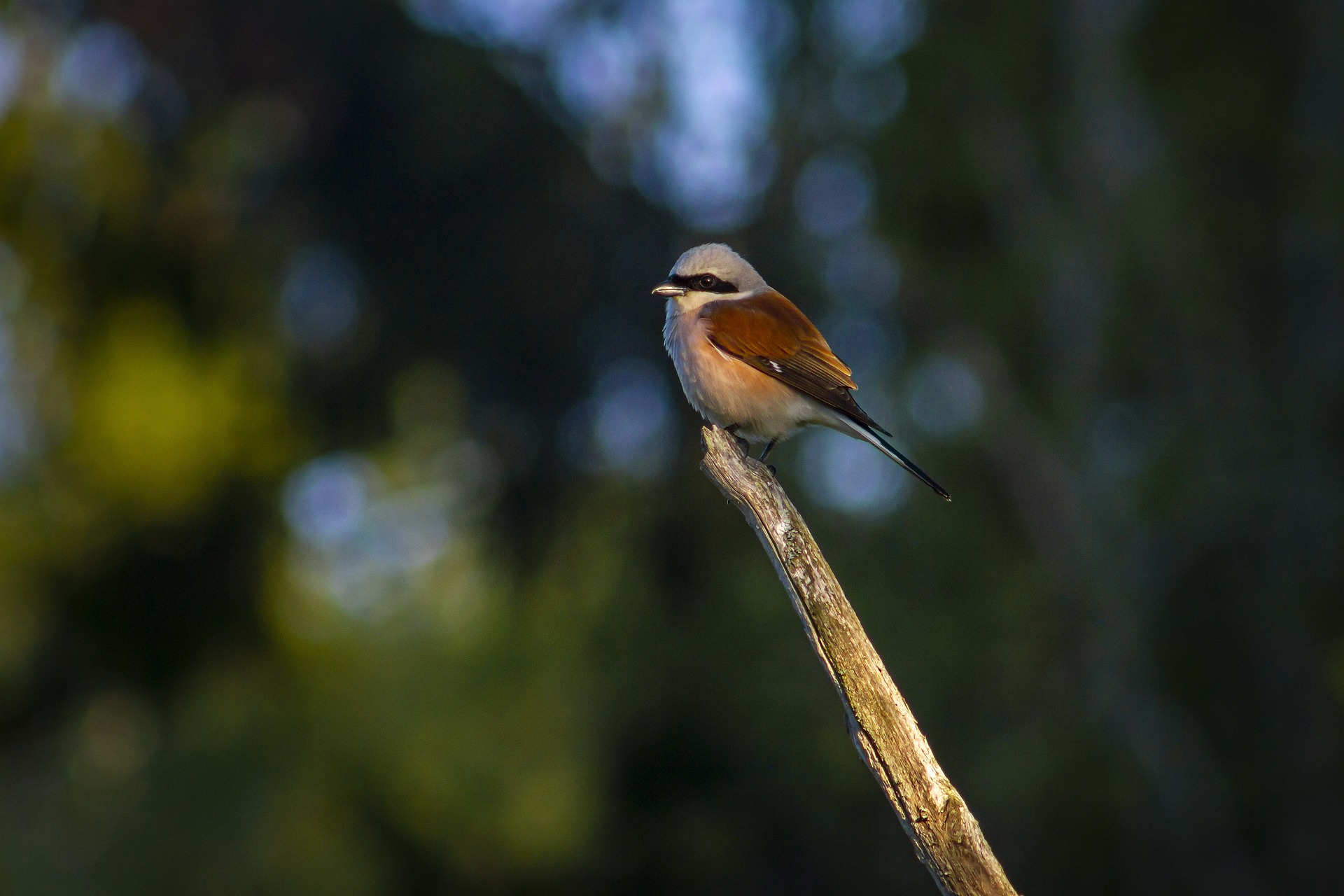The Red-backed Shrike (Lanius collurio) is a small to medium-sized bird in the shrike family, known for its distinctive hunting behavior and striking appearance. This passerine bird is widely distributed across Europe, parts of western Asia, and migrates to sub-Saharan Africa for the winter. It inhabits open countryside, meadows, and shrublands, where it uses its keen hunting skills to capture insects and small vertebrates.
Physical Description:
- Size: The Red-backed Shrike is about 16–18 cm long, with a wingspan of 24–28 cm, and weighs around 20–30 grams.
- Coloration:
- Males: The adult male is easily recognizable by its striking plumage. It has a rufous-red back, grey head, and a distinctive black “bandit mask” stripe running across the eyes. The underparts are a pale pinkish-white, while the wings are darker, contrasting with the rusty red back.
- Females: Females have more subdued coloring, with brownish upper parts and less pronounced facial markings. Their underparts are lightly barred with brown, helping them blend into the environment.
- Juveniles: Juvenile Red-backed Shrikes resemble females, with a more muted color palette and barred underparts.
Behavior:
- Hunting and Feeding: Shrikes are often called “butcher birds” due to their unusual habit of impaling their prey on thorns or barbed wire. This behavior allows them to store food for later consumption and also aids in tearing apart their prey, which can include large insects, small mammals, birds, reptiles, and amphibians. The Red-backed Shrike typically hunts from a perch, using its sharp eyesight to spot potential prey, which it catches by swooping down swiftly.
- Diet: In the breeding season, the bird mainly feeds on large insects like beetles, grasshoppers, and crickets. It may also take small birds, mice, or lizards, especially later in the season when these are more abundant.
Habitat:
The Red-backed Shrike prefers open habitats with scattered bushes, hedgerows, and low vegetation, often near agricultural areas or grasslands. It needs perches like shrubs, fences, or small trees from which it can scan for prey. In its breeding grounds, it favors locations with a mix of open land for hunting and dense bushes for nesting.
Breeding:
- Nesting: Red-backed Shrikes are monogamous during the breeding season, and they build their nests in dense shrubs or thorny bushes. The nest is a cup-shaped structure made from twigs, grass, and other plant materials.
- Eggs: The female lays 4–6 eggs, which are incubated for about 13–16 days. Both parents participate in feeding the young.
- Fledging: The chicks leave the nest approximately two weeks after hatching, although they remain dependent on their parents for food for some time after fledging.
Migration:
The Red-backed Shrike is a long-distance migrant. It breeds in Europe and parts of Asia, but as summer comes to an end, it embarks on a journey to its wintering grounds in sub-Saharan Africa, typically in the savannah and open woodland areas. The migration southward takes place in late summer (August to October), with the return to breeding grounds occurring in late spring (April to May).
Distribution:
The Red-backed Shrike breeds across much of Europe and western Asia. It is more common in central and eastern Europe but can also be found in northern parts of Africa and the Middle East. During the winter months, it migrates to southern Africa, particularly to open, arid regions with scattered trees and shrubs.
Conservation Status:
The Red-backed Shrike has a conservation status of Least Concern according to the IUCN. However, its populations have experienced declines in some regions due to changes in land use, agricultural intensification, and the loss of suitable habitats, such as hedgerows and unmanaged grasslands. In western Europe, for example, it has become increasingly rare, whereas its populations are more stable in central and eastern Europe.
Interesting Facts:
- “Butcher Bird” Behavior: The shrike’s habit of impaling prey on thorns is not just for storage; it helps the bird deal with larger or difficult prey, which it then tears apart using its sharp, hooked beak.
- Mimicry: Red-backed Shrikes are known for their ability to mimic the calls of other birds, which may be used to deceive prey or communicate with other shrikes.
- Territoriality: During the breeding season, Red-backed Shrikes are highly territorial and will fiercely defend their nesting area from intruders, including other birds and predators.
Ecological Importance:
As both a predator and a prey species, the Red-backed Shrike plays an important role in its ecosystem. By controlling populations of insects and small vertebrates, it helps maintain balance in the food web. Additionally, the species’ reliance on thorny vegetation for hunting and nesting emphasizes the importance of conserving natural hedgerows and shrubby habitats, which benefit many other species as well.
Conclusion:
The Red-backed Shrike (Lanius collurio) is a fascinating bird known for its bold hunting behavior and striking appearance. Though its populations have declined in some areas due to habitat loss, it remains a widespread species across much of Europe and Asia. Its migratory lifestyle, unique feeding habits, and role in the ecosystem make it a species of great interest to birdwatchers and conservationists alike.
Views: 44
Subscribe to the newsletter:
